Atmospheric Pollutants and Greenhouse Gases pt. 1: Air Quality
1/16
Earn XP
Description and Tags
Mostly about pollutions effects on human health.
Name | Mastery | Learn | Test | Matching | Spaced |
|---|
No study sessions yet.
17 Terms
What does the air consist of? composure of air basically
Nitrogen
Oxygen
Argon
CO2
Others (He, Ne, CH4, H2, Kr, N2O…)
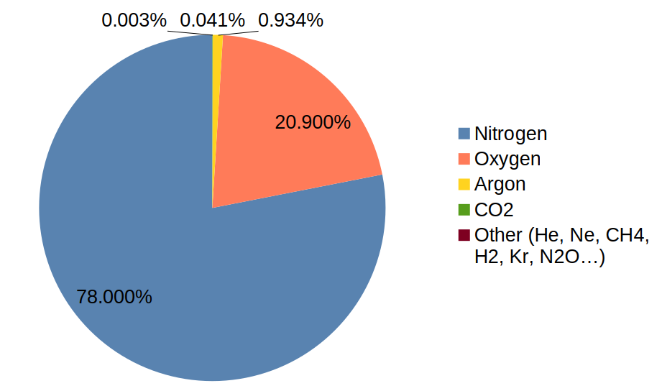
Why is air pollution an important topic?
In 2012, 1 in every 9 deaths was a result of air pollution-related conditions. Around 3 million deaths worldwide was solely ambient air pollution. It affects all regions, settings, socioeconomic groups and age groups.
Combined effects from ambient air pollution and indoor air pollution caused approximately 7 million premature deaths and an increase mortality rate from IHD, COPD, lung cancer and acute respiratory infections.
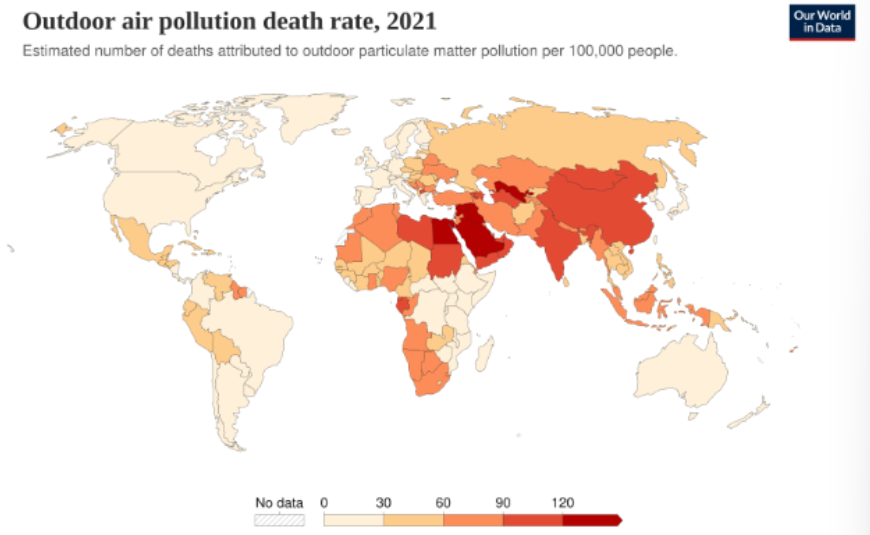
Which pollutants are important to know?
NOx (NO and NO2)
Ozone (O3)
Carbon monoxide (CO)
Sulphur Dioxide (SO2)
Particulate matter (PM 2.5, PM 10)
Benzene (C6H6)
Lead (Pb)
CFC
Green house gases (Climate pollutants): CO2, CH4, N2O, H2O, SF6, H2 etc…
Many more of course.
Oxides of Nitrogen (NOx)
NO and NO2
Reddish brown gas
Sources:
NO → Emissions from traffic with some contribution from other combustion (e.g. heating, energy industry..)
NO2 → Secondary pollutant
NO2 health impacts: affects lung and throat (chronic and acute effects).
Contributes to the formation of acid rain and Ozone.
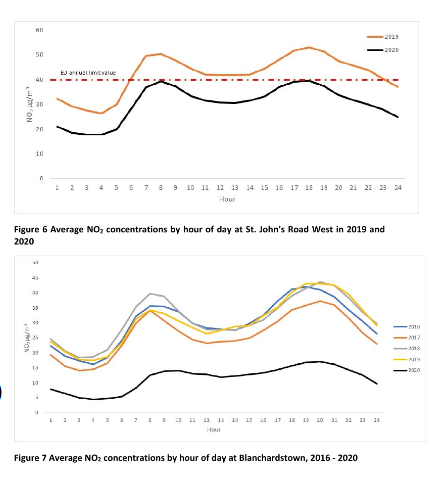
Ozone (O3)
Pale blue gas
Source: Secondary pollutant created by the reaction of UV light and NO2..
NO2 + hν → NO + O∗
O∗ + O2 → O3
O3 + NO → O2 + NO2
Stratospheric ozone goodie but NOT ground level ozone…
Health impacts: acute high concentration affect respiratory tract, long term exposure can worsen heart disease.

Carbon Monoxide (CO)
Colourless, odourless gas
Source: Emissions from traffic, with some contribution from other combustion (e.g. Peat/Firewood burning)
Health impacts: Absorbed into bloodstream instead of O2.
Prolonged exposure to small concentration can cause tissue damage.
Acute poisoning can lead to death.
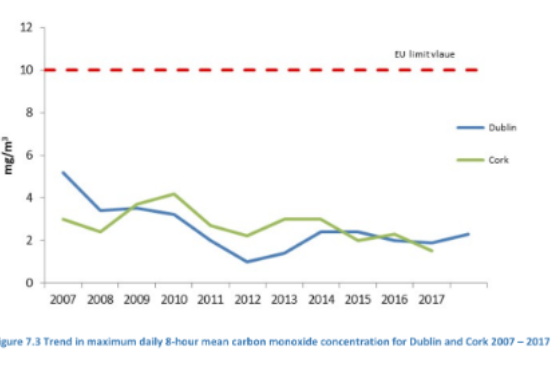
Sulphur Dioxide
Colourless gas.
Source: Coal and oil burning to heat homes (peat) and electricity production.
Health impacts: Affects lung and throat (chronic and acute effects)
Contributes to formation of acid rain.

Particulate Matter
Solid and liquid particles: Smoke, dust aerosols, pollen etc..
PM10 (less than 10um diameter) and PM2.5 (less than 2.5um diameter)
Source: Fuel combustion (e.g. traffic, heating), construction, soil and road surfaces etc..
Can also be secondary pollutant.Health impacts: Affects lungs, chronic respiratory disease, links to cardiovascular disease, smaller particles can move further down into lungs and even cross into bloodstream.
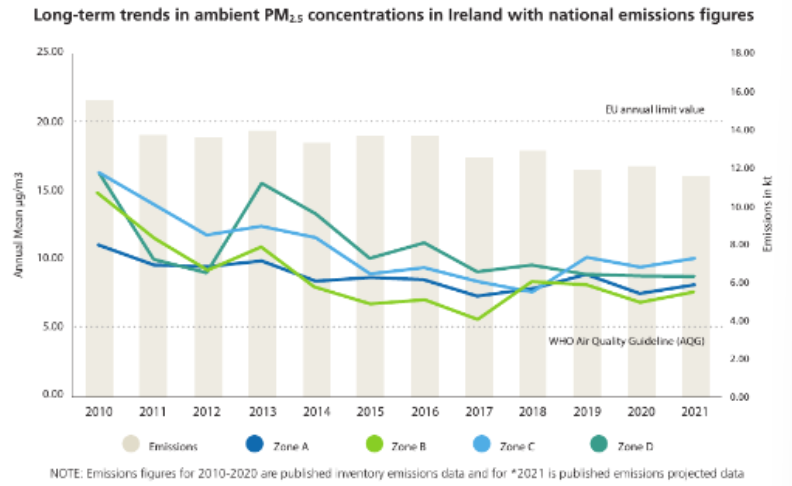
Air pollution legislation in Ireland and Europe
European Commission Air Quality Framework Directive in 1996: Four ‘‘daughter’’ directives were laid down limits for specific pollutants.
1st Daughter Directive: SO2, NOx, particulate matter and lead.
2nd Daughter Directive: CO and Benzene
3rd Daughter Directive: Ozone
4th Daughter Directive: Polyaromatic hydrocarbons, arsenic, nickel, cadmium and mercury in ambient air.
Clean Air for Europe (CAFE) Directive 2008/50/EC
Published May 2008, in forced on June 2010
Replaces framework and the first THREE daughter directives.
Limit value - Legally binding under EU law
Level fixed on the basis of scientific knowledge to avoid long-term harmful effects on human health and/or the environment as a whole.
To be attained within a given period and not exceeded once attained
Target value
To be attained where possible over a given period of time
Information threshold
Level beyond which there is a risk to human health from brief exposure for particularly sensitive sections of the population
Immediate and appropriate information is necessary
Alert threshold
Level beyond which there is a risk to human from brief exposure for population as a whole.
Immediate steps shall be taken.
Limits, target values and alert or information thresholds.
These are the averaging periods and units


Air Quality Index for Health
Number from 1 - 10, describes current air quality in region
Calculated every hour
Six region: Dublin city, Cork city, Large towns (pop. >15000), Small towns (pop. >5000 but <15000), Rural West & East.
Based on five pollutants:
O3
NO2
SO2
PM2.5
PM10
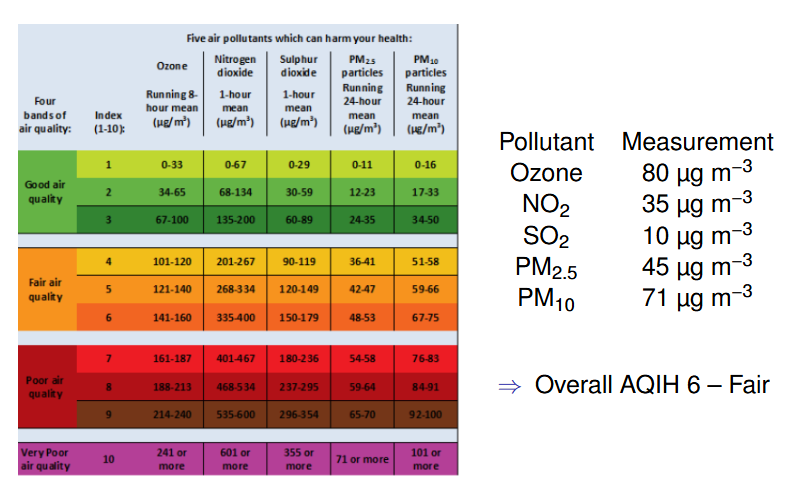
What causes bad air quality?
High emissions
Low mixing and transport rates
Temperature inversions can lead to very low mixing and an accumulation of pollutants
Some locations and seasons more prone to inversion events → higher risk of bad air quality.
Example: Great smog of London, December 1952
- High emissions from coal burning due to cold weather
- Anticyclone caused temperature inversion trapping air underneath → ‘‘pea-souper-’’